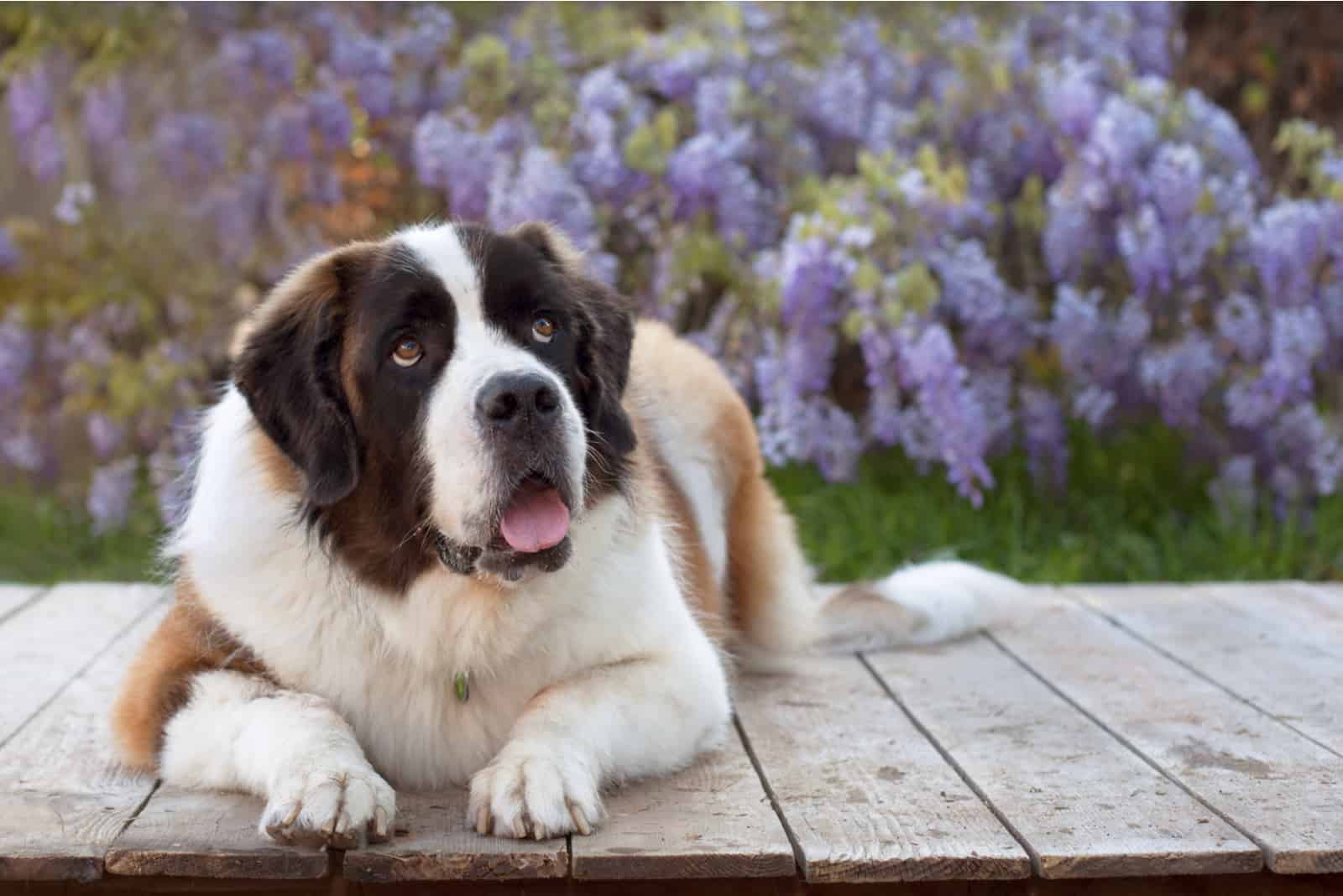Are you interested in the many Saint Bernard colors? There is more to this topic than meets the eye!
Saint Bernards are the Swiss ’ gentle giants and beloved members of the canine family. Despite their huge size, there is nothing dangerous about these working dogs. In fact, they are most popular as kind family pets and companions for your children – although they also make amazing watchdogs.
These dogs originally guarded the St. Bernard Pass, named after the Saint Bernard de Menthon, located on the Switzerland – Italy border. It isn’t certain if they were named after the saint or his path that they carefully guarded.
They were also used for locating and saving lost and injured travelers, sometimes even on the dangerous boulders of the Swiss Alps.
Today, they do a lot of rescue work, and they are considered to be heroes of the canine world.
While it is believed they are related to the extinct Alpine Mastiff, it is important to note that these two are entirely different dog breeds – although they have the same origin.
While not ranking high on the American Kennel Club ( AKC ) lists, these large, long-haired dogs are still beloved by many because of their kind and friendly nature. They were even heroes in several popular films, most notably the 1992 movie “ Beethoven. ”
Several well-known dogs belonged to this breed, such as Barry der Menschenretter, a mountain rescue dog that is known for rescuing dozens of people.
In fact, when people think of the Saint Bernard dog breed, they imagine a large breed with a distinguishable pattern that even the dog named Beethoven from the movie we mentioned before had.
But did you know that Saint Bernards can come in 17 different shades?
Are Coat Colors Important?

If you try Googling this question, you’ll probably read that a dog’s coat color doesn’t really matter. All dogs are beautiful, and each color is special. Not just that, but so far, not a single research paper has managed to prove a connection between a dog’s fur color and its personality.
While this is true, in the last few years, some experts have dared to argue that anecdotal records and even some recent studies suggest that a canine’s coat color can directly relate to its health.
For example, the University of Sidney conducted research that showed that the expected lifespan of chocolate-colored dogs is somewhat shorter than the lifespan of dogs in other colors.
This can be connected to the claims of a study published in The Canadian Veterinary Journal that states that certain coat colors and patterns are related to specific neurologic and, more notably, neuro-ophthalmic diseases. This is mostly the case with dilution genes, but more on that later on.
Some of the conditions connected with coat color include congenital blindness, sensorineural deafness, and albinism.
Taking all of this into account, it’s dangerous to claim that colors don’t really matter. If you understand the dangers of certain colors, you might make a better, more informed choice the next time you bring a new puppy home.
What Are The Standard Saint Bernard Colors And Markings?
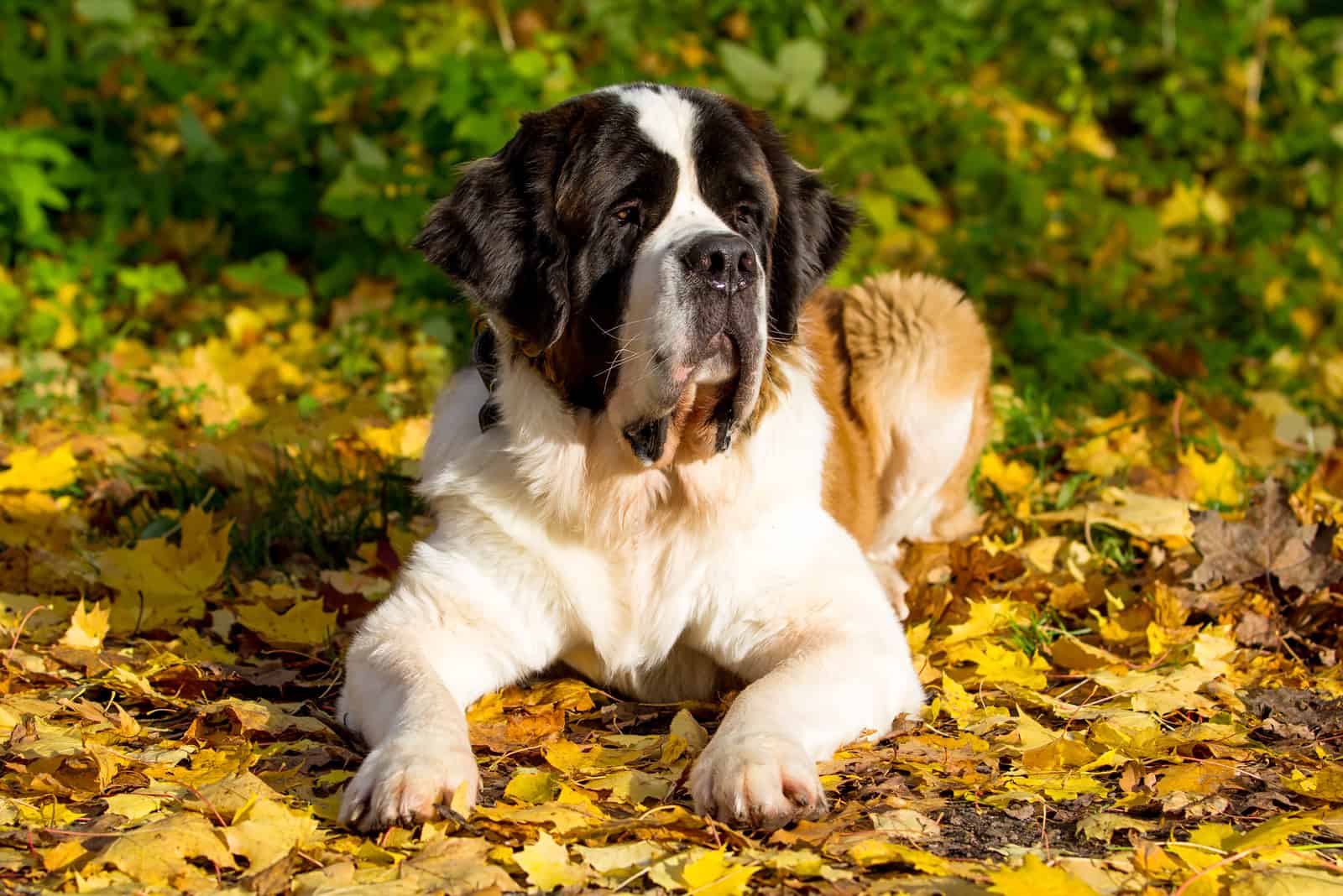
Talking about accepted colors for any dog breed can be somewhat complicated. This is because there are several kennel clubs, and not all of them have the same breed standards.
We’ll look at three of the largest kennel clubs: The American Kennel Club ( AKC ), Fédération Cynologique Internationale (FCI), and United Kennel Club (UKC).
According to the AKC, standard Saint Bernard colors and color combinations are:
• White and red
• White and orange
• White and brown
• Rust and white
• Red and white
• Orange and white
• Mahogany and white
• Brown and white
• Brindle grizzle
If we were to ask the UKC, they would say that acceptable colors are all shades of red and white, as well as all shades of brown and white.
On the other hand, the FCI’s acceptable colors include broken reddish-brown mantle, white with clear red patches, brownish-yellow, and brindle reddish-brown.
These 13 coat colors are considered standard. While other colors and combinations can occur, most kennel clubs don’t accept them. This is because some colors are not observed enough, and experts still have to prove if they can be connected to certain health issues.
Just like with coat colors, there are specific markings Saint Bernards should have to be recognized by these kennel clubs. We’ll look at the breed standard according to the UKC, as this club created the most detailed description.

Photo from @rugbythestbernard
According to it, Saints need to have white markings on the following body parts:
• Noseband
• Nape of the neck
• Collar
• Chest
• Feet
• Tip of the tail
On other spots, white markings are desirable but not required. These include:
• Muzzle
• Blaze between the eyes
• Tummy
• Legs
• The lower half of the tail
Also, Saint Bernards should have a darker mask around their eyes, as well as a darker shade on their ears. Just like with these white spots, the dark markings are not required, but the dog should have it if you want a dog that entirely fits the breed description.
Further on, when we talk about white or dark markings, these are the markings we’re talking about. Keep in mind that Saint Bernard crossbreeds, such as the Saint Bernedoodle or a Corgi Saint Bernard mix, tend to come in some other patterns, and this doesn’t apply to most of them.
A Brown And White Saint Bernard
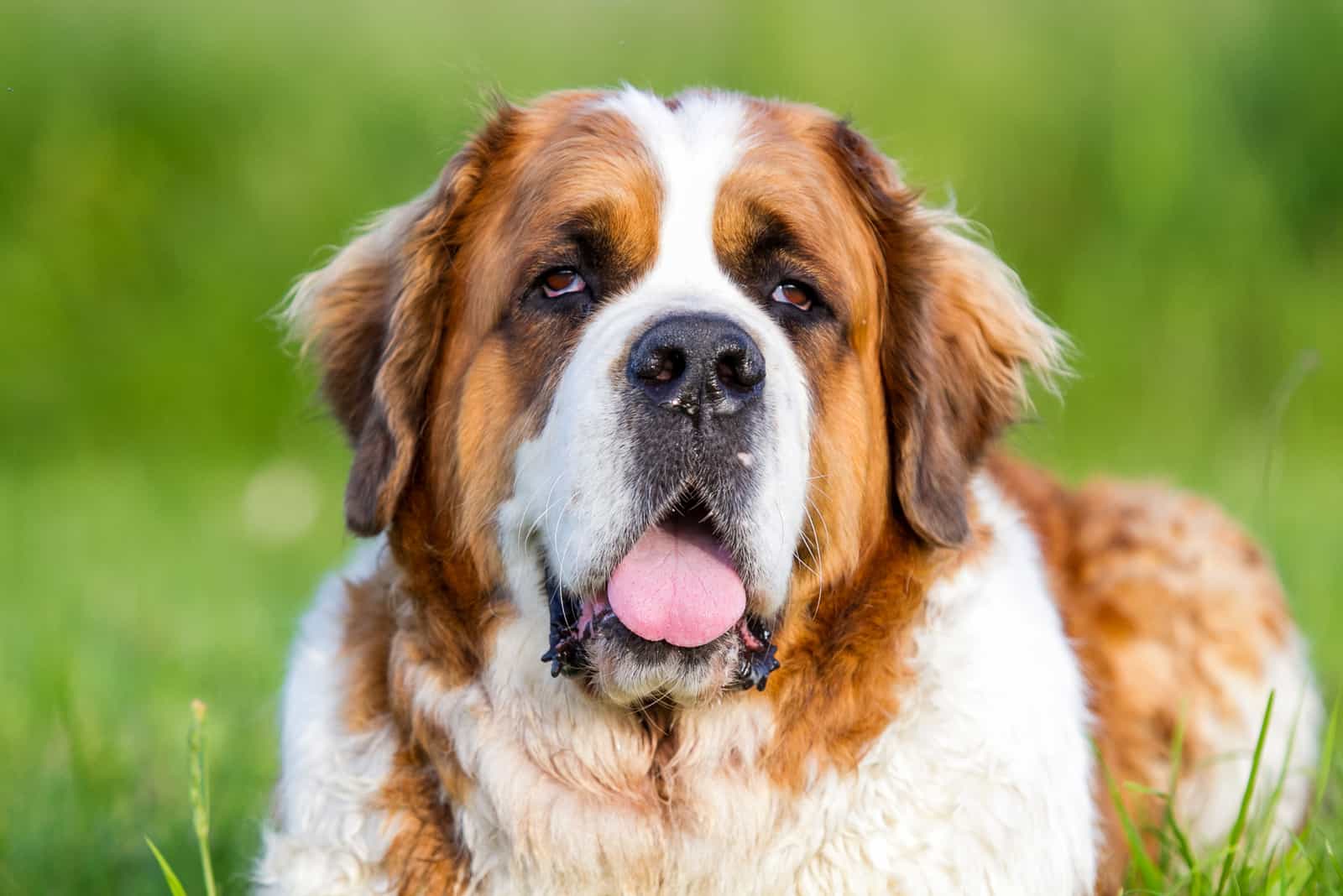
A brown and white Saint has a shiny tan brown coat that can sometimes be confused with silver or beige. They have desirable white and black markings on their body, which contrasts with the rest of their fur.
This is the coat color most people think of when they imagine a Saint Bernard.
An Orange And White Saint Bernard
This is another pretty standard color for this dog breed. In fact, you’ll commonly see it in cartoons or animated movies, as it gives these dogs a cute appearance.
The orange base color is caused by a pigment called phaeomelanin, which is also located in a dog’s skin. Phaeomelanin is also responsible for tan, red, cream, gold, and yellow shades.
A Brindle Grizzle Saint Bernard
Brindle grizzle Saint Bernards are unique in that their base color is a combination of two shades. However, you’ll probably recognize them by the tiger-like stripes located on their fur.
To help you understand what a brindle grizzle Saint Bernard’s color is, we’ll explain how this color is different from regular brindle.
Grizzle dogs have a coat that doesn’t come with any discernable pattern. This means that the shades are blended so well that they seem to be the same shade – however, as soon as you look closely, you’ll notice the subtle differences between them.
Most brindle grizzle Saint Bernards have a mix of black and brown hairs, but you can also find them in white and red color combinations.
A Mahogany And White Saint Bernard
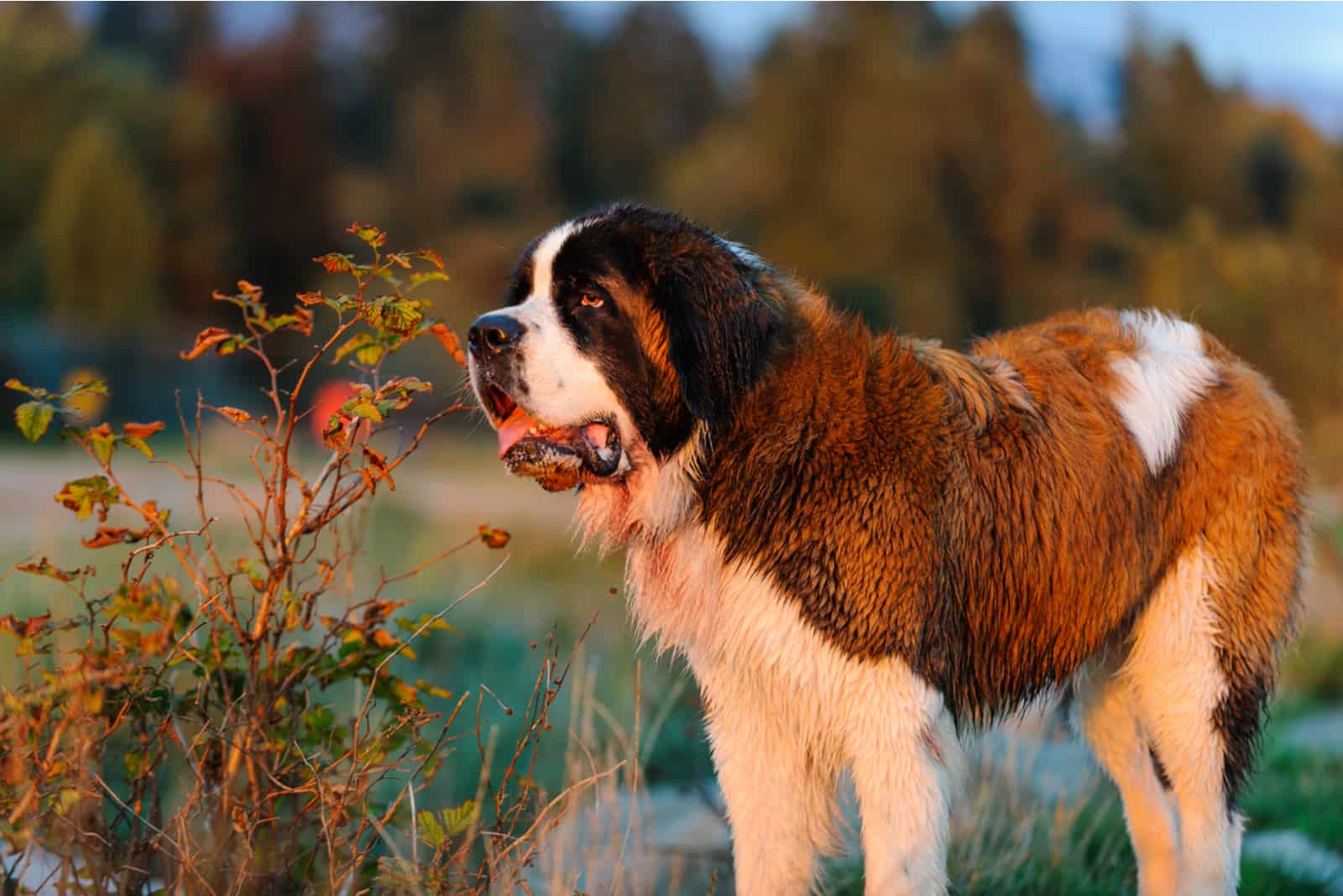
These Saint Bernards have a coat that is medium-saturated and in a reddish-brown color. In contrast to this fur color, they have white markings on various parts of their body and a black mask over their eyes and ears.
A Red And White Saint Bernard
These dogs have a red base coat that is contrasted with white markings on their body and a black mask on the dog’s head. It’s another fairly common coat color in this dog breed.
A Rust And White Saint Bernard
According to the AKC, the rust color is actually a medium brilliant reddish-brown shade. It could also be considered a variation of the red color, and it’s caused by the same pigment, phaeomelanin.
Typically, these dogs have white markings and a black mask, but this is not necessary.
A White And Brown Saint Bernard
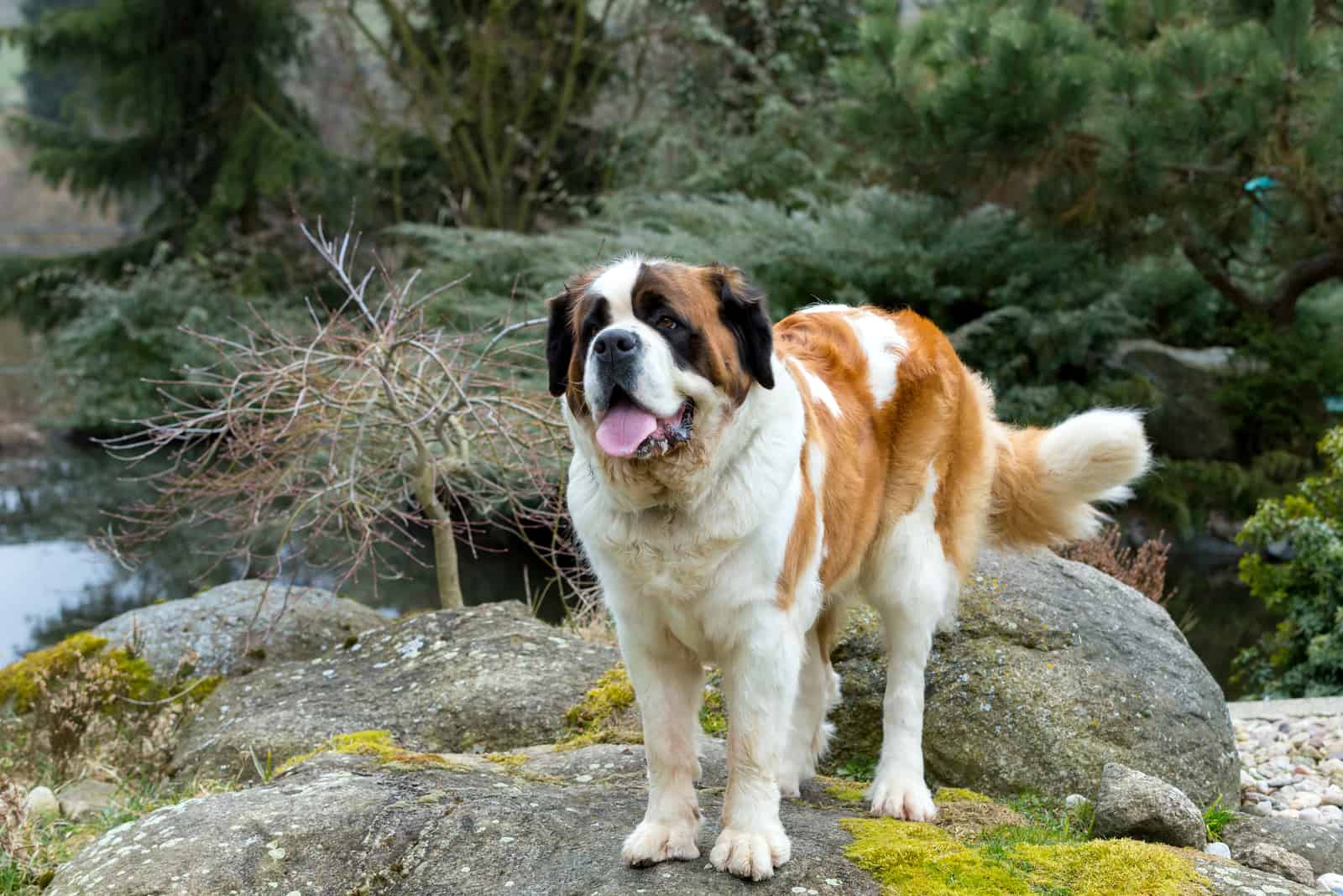
If you think we’ve already talked about this color combination – you are wrong. White and brown Saint Bernards are not the same as brown and white ones.
If this is confusing, here’s one thing you should know: When talking about dog coat colors, the first color mentioned is the base color. In brown and white Saints, the base color is brown. However, in white and brown Saints, white is the base.
In other words, in white and brown Saint Bernards, the primary color of their coat is white, while they have brown markings.
This, however, doesn’t mean that they are an ‘inverted’ brown and white Saint Bernard. If you were to look at a picture of these dogs, you’d notice that they simply have a lot more white on their bodies than brown.
Their nose, stomach, tip of their tail, and feet will always be white, and a black mask is desirable.
Keep in mind that the UKC and the FCI haven’t specified that the amount of white color compared to the darker shade is important for classifying it as a different coat color.
A White And Orange Saint Bernard
Similar to the previously mentioned white and brown combination, white and orange Saint Bernards are white-coated with orange markings. The white color will always be the more dominant one.
Once again, the white has to remain in the necessary spots for white markings, and a black tint on their ears and eyes is desirable.
A White And Red Saint Bernard
These dogs are similar to red and white Saints, but they have more white in their coats than the darker shade. They should also sport darker markings around their eyes and on their ears.
A Brownish-Yellow Saint Bernard

The brownish-yellow color in Saint Bernards is the result of a gene mutation that causes color dilution. The specific gene in question is called the D Locus. It can affect most yellow, brown, and black dogs.
Similar to most other color combinations, brownish-yellow Saint Bernards also have white markings and a black mask.
A Reddish-Brown Brindle Saint Bernard
These dogs have a reddish-brown base color with stripes that resemble those of a tiger. These stripes can vary in shade from barely noticeable to being almost entirely black.
A Reddish-Brown Splash Saint Bernard
If you’re wondering what type of pattern splash is – it’s just another word for piebald.
These Saints have a reddish-brown base and white markings that are irregular and can be located anywhere on their bodies. Keep in mind that they still have to be located on their noses, tummies, feet, and tip of their tails.
The white patches are a result of a lack of pigment production. While they do interrupt the pigmented part of the coat, they don’t look ticked.
A Reddish-Brown Mantle Saint Bernard
This is a reddish-brown Saint Bernard but with a shaded portion usually located on the shoulders, sides, and back. These shadings can be either reddish-brown or white, but white cannot be the dominant color.
These dogs still have distinguishable white markings and dark masks.
What Are The Non-Standard Saint Bernard Colors?
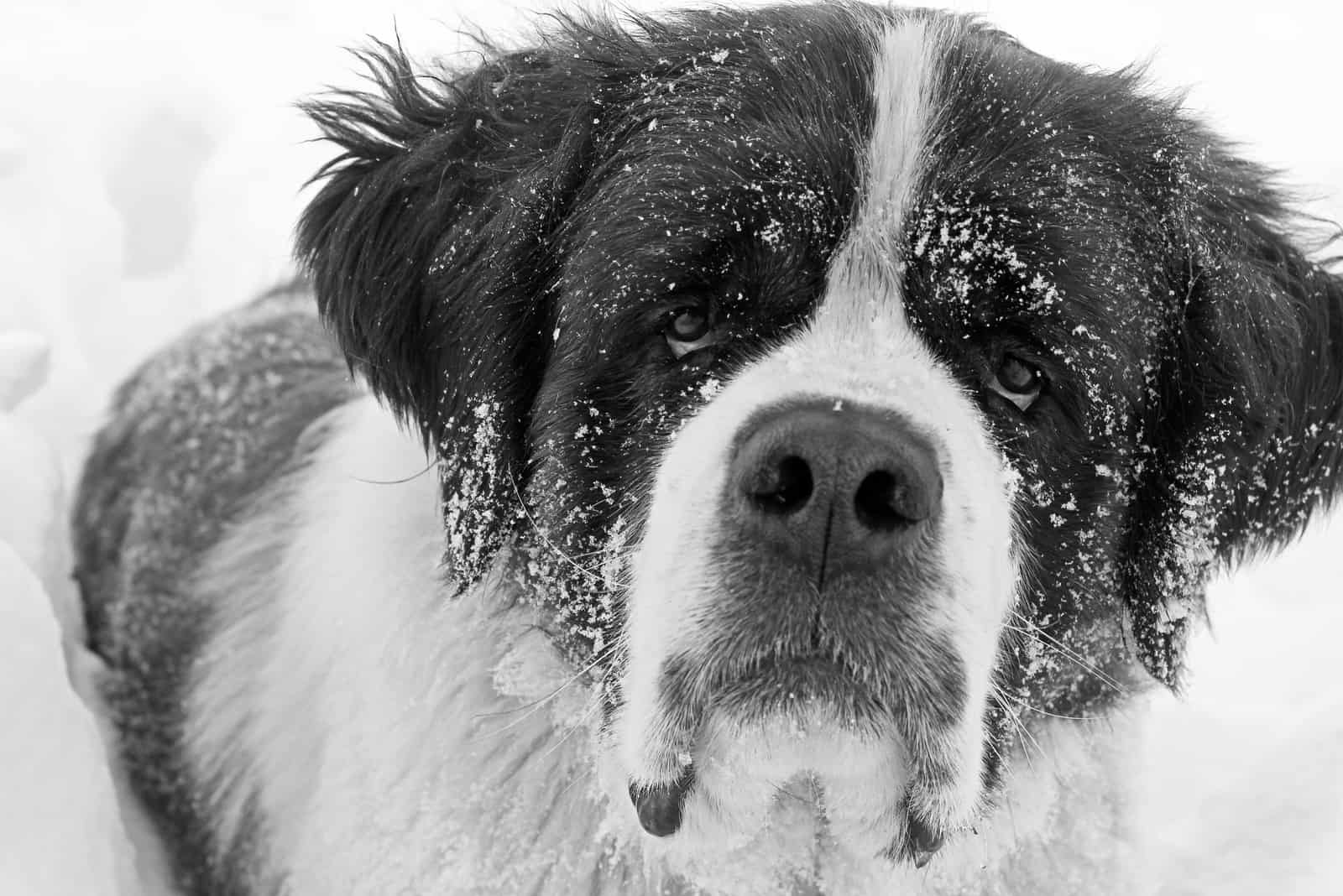
Some colors are simply considered non-standard by the AKC, FCI, and UKC. This is one thing these kennels are united about. This is because most of these colors are connected with higher risks of developing certain health conditions. Here are these colors and patterns.
A Solid Color Saint Bernard
By now, you have probably noticed that all of the mentioned Saint Bernard colors are a combination of a few shades. While patterns such as splash, brindle, and mantle are desirable, single colors are not a common sight in Saint Bernards.
This is because a Saint Bernard in a solid color is undesirable by all of the highest-ranking kennel clubs.
While there isn’t a precise explanation behind this, people say that solid color Saint Bernards come with a plethora of congenital disabilities.
A Saint Bernard Without White Markings
This is another Saint Bernard color that people frown upon. While there are no serious issues with these doggies and no health issues seem to be connected with the lack of this color, Saint Bernards without white markings are deemed undesirable.
A Black And White Saint Bernard
Some Saint Bernards have distinctive white markings but don’t have any red or brown tones on their fur. This is another combination that isn’t allowed by top kennel clubs.
It is believed that people breed dogs in this color pattern purely because of their appearance. They are often a product of inbreeding, so no other pigment could enter their genetic pool.
Because of this, such breeders and dogs are condemned not just by many breeders but also dog lovers worldwide.
An Albino Saint Bernard
By now, it is common knowledge that albino animals carry a large number of problems, such as blindness and deafness. The same goes for the Saint Bernard breed.
Albino Saint Bernards are easy to identify as they have a snow-white coat without any markings, and their nose is pinkish. Instead of dark eyes, they have blue or even reddish eyes.
Breeding albino Saint Bernards is deemed unethical, as these breeders are promoting the reproduction of animals with severe sight and hearing problems.
Saint Bernard Color Pricing
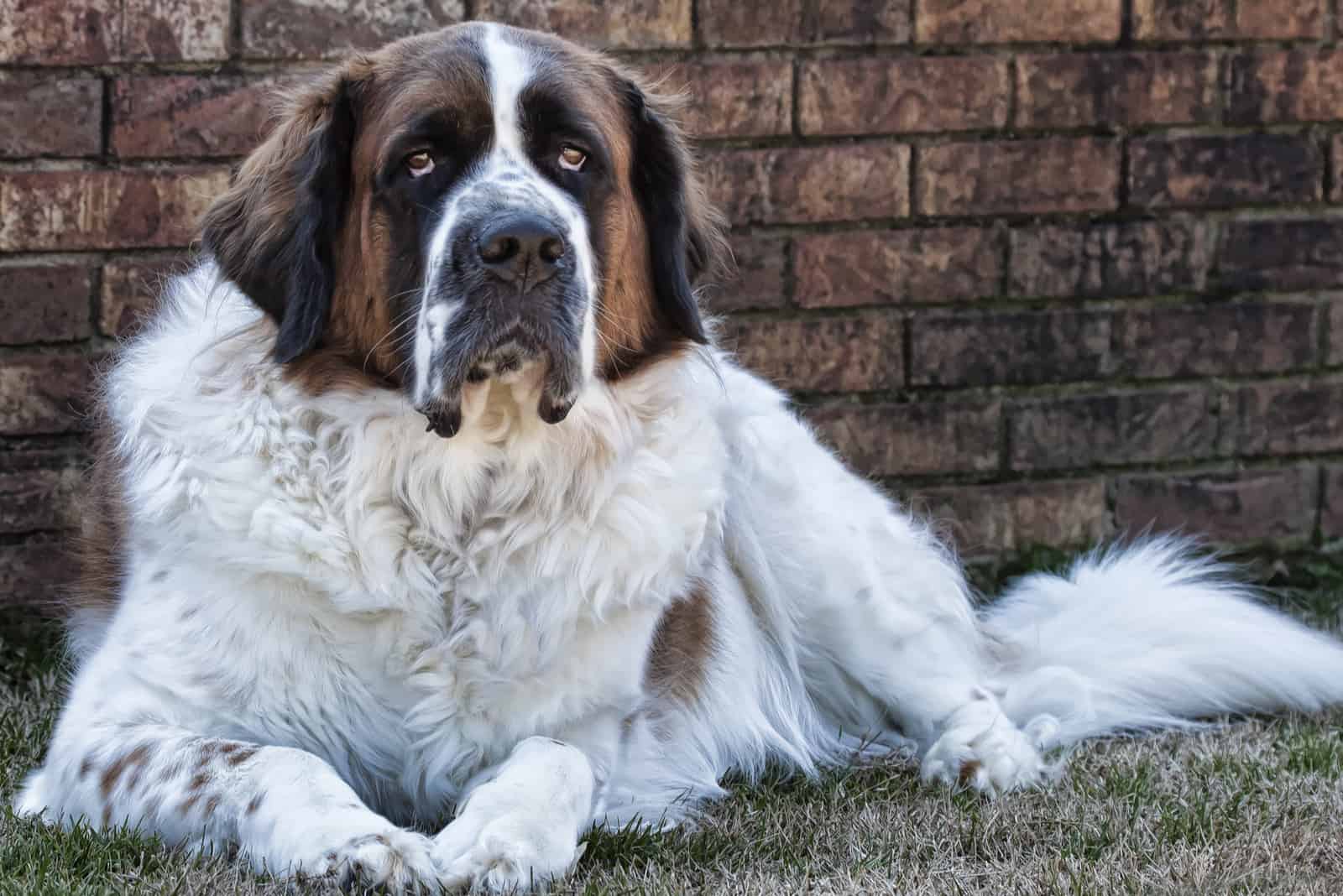
Many things influence the price of purebred Saint Bernard puppies, such as the breeder’s reputation or the area. However, the rarity of the color can also cause the price to escalate.
Three of the rarest Saint Bernard colors are brindle grizzle, mahogany and white, and brownish-yellow. These dogs can cost thousands of dollars, especially if they come from reputable breeders.
If you want a more affordable dog, look for these color combinations:
• Orange and white
• Brown and white
• White and red
• Red and white
• White and brown
Keep in mind that even Saints in these typical colors can still end up being quite costly, as these are large dogs that aren’t easy to breed.
Black and white Saints are also very common, but we wouldn’t advise getting one. As we’ve mentioned before, these dogs are typically a product of incest, so they can come with several health problems that plague many large-size dogs such as the Great Dane or Newfoundland.
These diseases include hip dysplasia, elbow dysplasia, bloat, entropion, and epilepsy. All of these conditions can affect the quality of life and life expectancy of your pup.
The length of the fur might also cause the price to go up and down. While most Saints have long hair, shorthaired variations also exist, but due to their rarity, their cost is usually a bit higher.
Read More: Saint Bernard Growth Chart
Saint Bernard Color Genetics
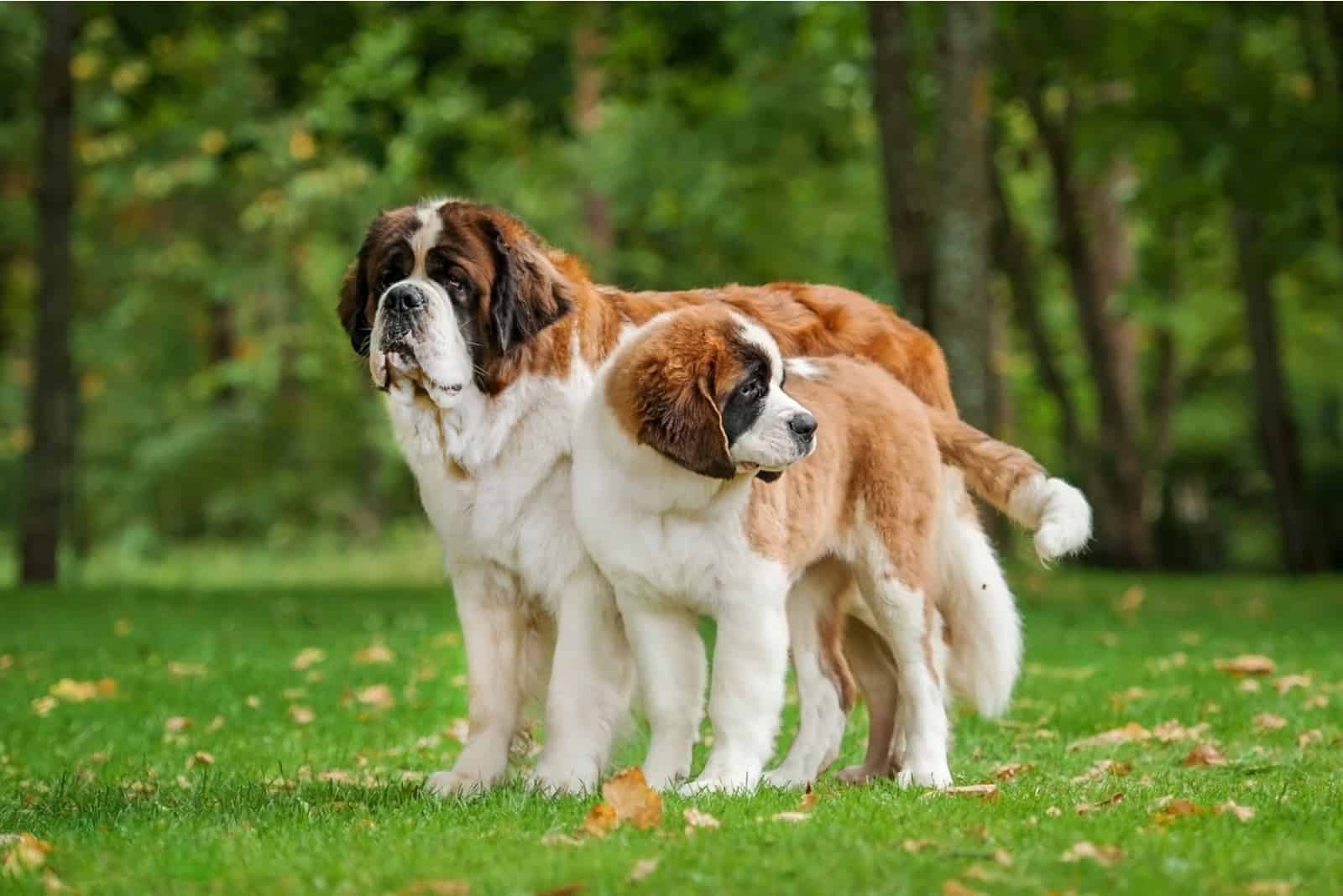
As you can see, Saint Bernards come in a variety of coat colors and patterns. What causes this vast number of shade possibilities?
There are two pigments responsible for most of the fur colors: eumelanin and phaeomelanin, the latter of which we’ve mentioned before.
While phaeomelanin is responsible for the red and yellow coat shades, eumelanin is the pigment that makes your dog’s fur black. Sometimes, though, a pup will be brown (either liver or chocolate), Isabella, or blue, in cases when genes alter the concentration of eumelanin.
These lighter coat colors are considered dilutes. It isn’t rare for them to have lighter eyes, nose, and rims of the eyes, depending on the specific genes.
So, what controls the combination of phaeomelanin and eumelanin in a dog’s body?
This gene is called the A (Agouti) Locus, which contains four alleles that determine the exact shade of coat color. Depending on those alleles, a dog with phaeomelanin might, for example, have a mahogany coat, while another one might have cream.
When it comes to the white coat color, it is the result of cells not being able to produce any pigment. Those with white markings are mildly affected. However, dogs with disorders such as albinism are affected dramatically.
How Much Does Coat Color Affect A Saint Bernard’s Health?
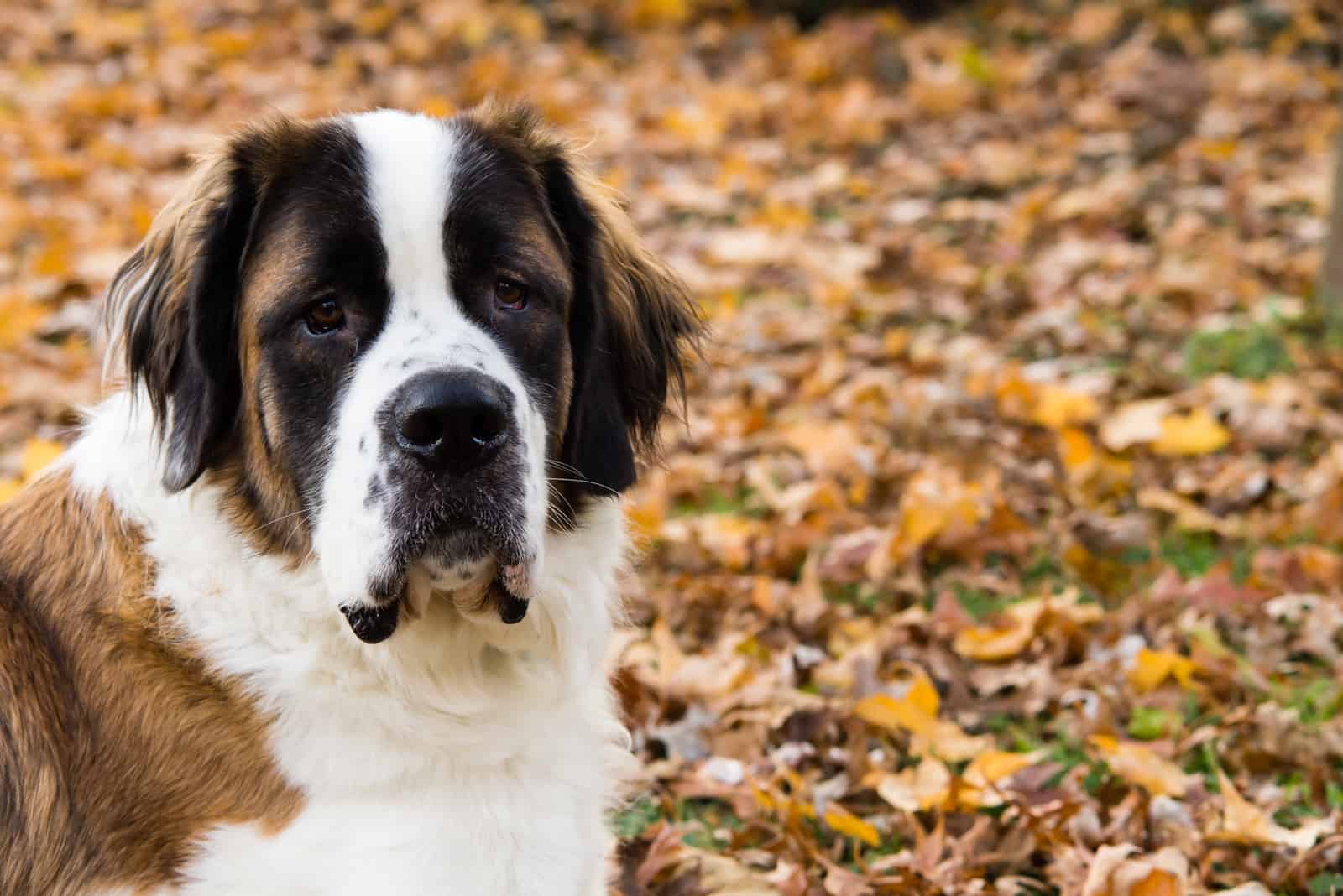
Despite what some people claim, so far, there is no indication that a Saint Bernard’s coat color can affect how that dog behaves. However, there is certainly proof that some fur colors make dogs more vulnerable to diseases. This includes most colors that kennel clubs don’t recognize as typical for the breed.
Albino, solid color, and black and white colors are among them, just like dogs without white markings. Dogs with these colors and patterns usually don’t meet the breed’s life expectancy, which is between eight and ten years.
In fact, these shades greatly increase the risks of many diseases that Saint Bernards are prone to. Here are some of them:
Congenital Deafness
This is a condition that affects the hearing of affected dogs – usually albino dogs. While this health defect isn’t curable, dogs can live a long and healthy life even if they’re entirely deaf.
Signs of this condition include excessive barking, failure to respond to any sound, hyperactivity, and making unusual noises.
Congenital Blindness
This disorder is similar to congenital deafness, except that it affects the dog’s sight. A dog affected by it will have a cloudy eye appearance and might look confused, dazed, and easily startled.
Like dogs with congenital deafness, blind dogs can still live long and healthy lives despite not being able to see at all.
Cardiomyopathy
Cardiomyopathy is a disease that affects the muscles of the heart and weakens the contractions. This results in impaired blood circulation and a weakened heart.
There are no early signs that you can notice and take necessary steps to prevent it.
Seizures
Saint Bernards can be prone to seizures, and dogs in colors not recognized by the kennel clubs are at higher risk of this condition. While this is not necessarily connected to a dog’s colors, breeders that produce unregistered dogs usually don’t conduct genetic testing for these diseases.
There are four types of seizures a Saint Bernard might have: generalized seizure, psychomotor seizure, focal seizure, and idiopathic epilepsy.
Osteosarcoma
Osteosarcoma is a type of bone cancer that mostly targets the limbs. However, it can reach other bones, including the skull.
One of the most noticeable signs of osteosarcoma is lameness.
Distichiasis
This disease is also known as double eyelashes. It’s a rare condition where a dog has two rows of eyelashes or eyelashes that have developed in abnormal areas. This can cause discomfort and vision loss.
Will A Saint Bernard’s Color Change From Puppyhood?
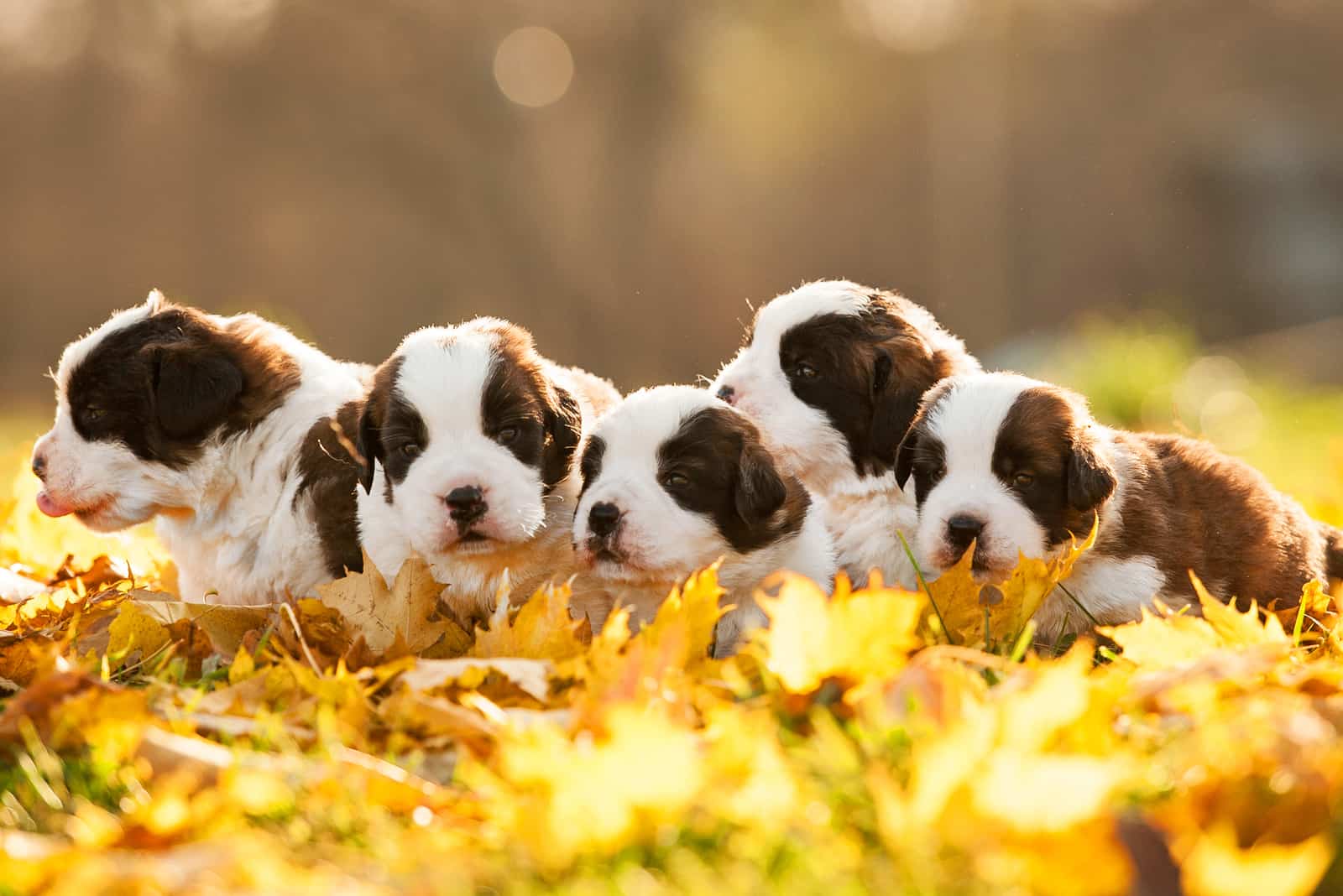
As is the case with many other dog breeds, a Saint Bernard can change color as it grows older, but these changes will more likely be subtle and not as drastic.
For example, a bright red puppy might become mahogany after a few months. This is because the pigment progresses as dogs become older.
However, a coat color might change in adult dogs, too, but this usually isn’t from natural pigment distribution. There are a few reasons why this might happen, and they include:
• Change in nutrition
• Sunlight exposure
• Skin disease
• Reaction to medication
To ensure your dog’s coat color stays shiny and doesn’t change, you need to take care of your pup’s diet. Feed him only healthy foods rich in omega-3 and omega-6 acids. If you’d like, add tuna or fish sticks to his weekly meal plan. You can find more useful information on this dog’s diet in our Saint Bernard feeding chart.
You might also want to replace store-bought treats with healthy alternatives from your kitchen. Safe and healthy dog treats include:
• Paprika
• Turnips
• Durian
Are you interested in a dog breed that is known for changing coat color? Find out who we’re talking about here.
How Much Does A Saint Bernard Shed?
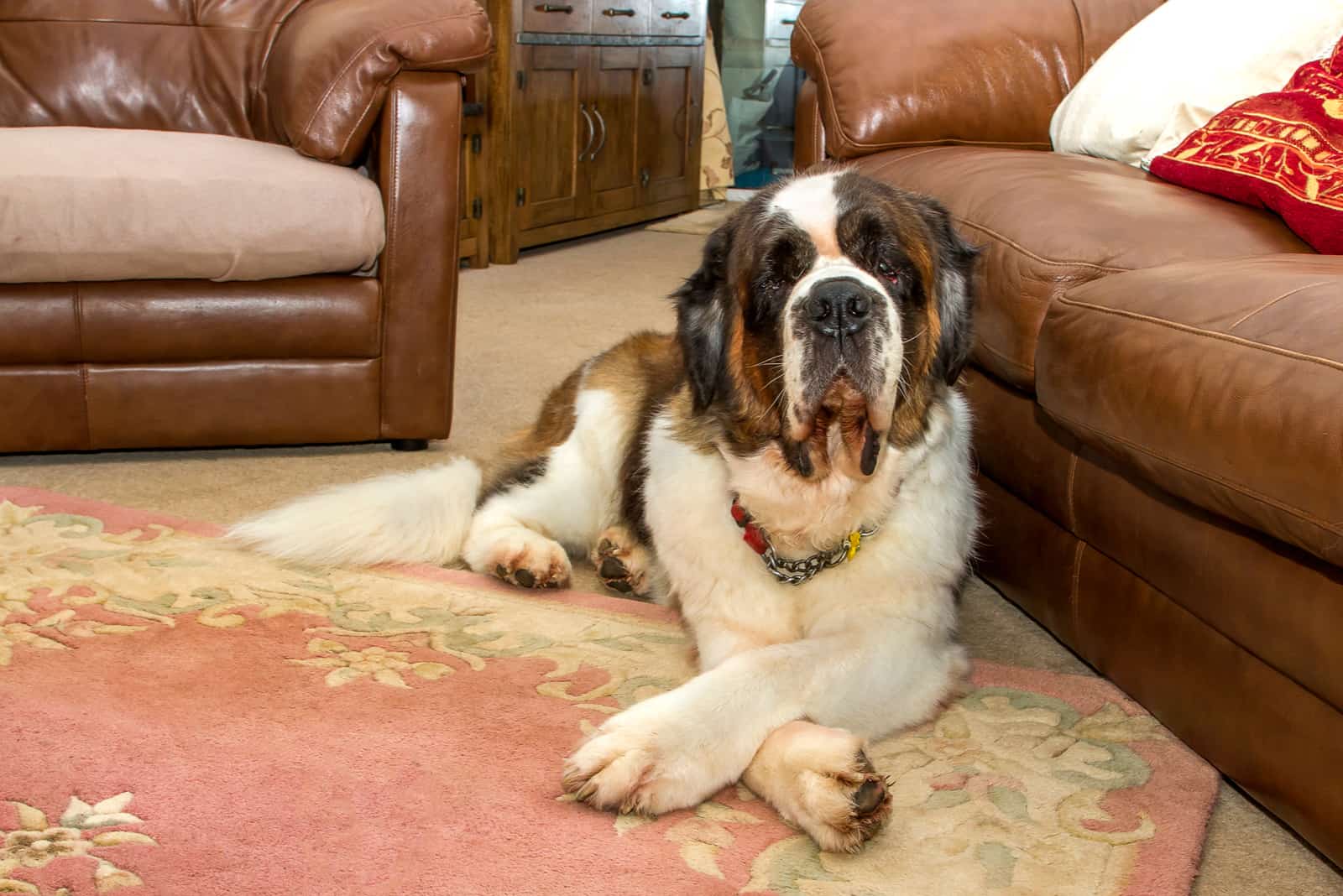
We cannot discuss the coat color of these large dogs without mentioning whether or not they’re difficult to groom.
As you may be able to conclude just by looking at them, Saint Bernards experience a lot of shedding. They’ll leave loose hairs everywhere!
Make sure to brush them once or twice a day, as this decreases the amount of vacuuming you’ll need to do. It will also help with tangles and keeping their coat nice and shiny.
There are more reasons why Saint Bernards are not the best dogs for neat freaks. Just like many other large dogs, such as Bernese Mountain Dogs, Tibetan Mastiffs, and Molosser, these dogs drool. This can create quite a mess!
Fortunately, grooming is the only thing you’ll really have to dedicate time to. Despite their size, Saints don’t have very high energy levels, and a moderate amount of exercise is fine for them.
However, as they are prone to obesity, you have to make sure they still get their daily long walks, even at a very young age. Just don’t let them overexert themselves in hot weather, as they are prone to heatstroke.
Are Saint Bernards Hypoallergenic?
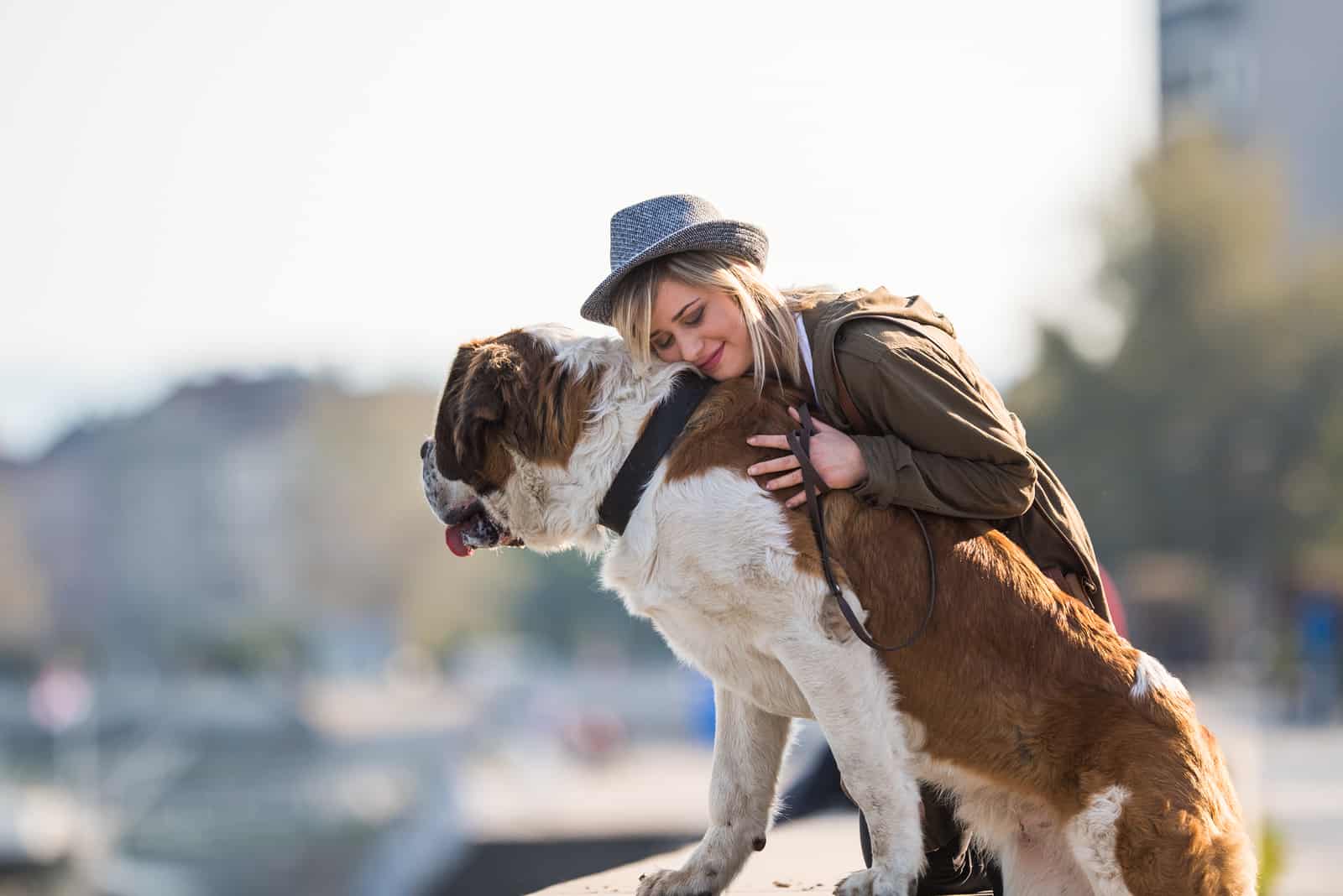
Saint Bernards are heavy shedders, so no, they are not hypoallergenic – although there is no such thing as a truly hypoallergenic dog.
Not just that, but due to the high amount of drooling, Saints produce more allergens than most other breeds.
If you are prone to dog allergies, this is a breed you should skip – or at least consult your doctor beforehand.
Where Can You Find Reputable Breeders?
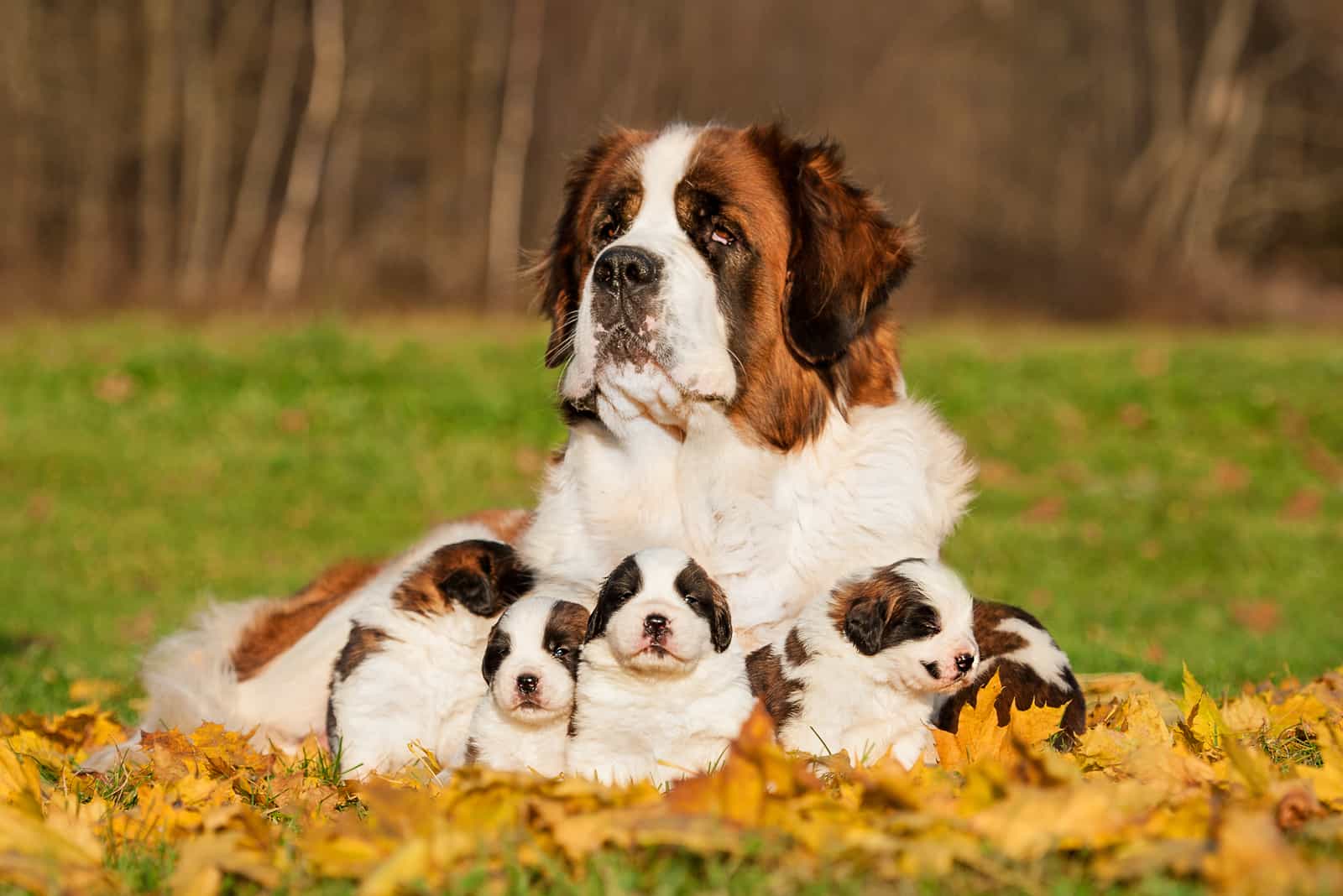
Reputable breeders will make sure their Saint Bernard puppies are not just of standard colors but also healthy overall. They’ll conduct necessary genetic screenings to make sure their dogs don’t have any underlying health conditions.
There is a good reason why some colors are considered desirable while others are not. It’s not just up to looks – some colors are connected to bad genes that can ruin the quality of your Saint’s life.
If you want to find a good breeder in your area, contact the Saint Bernard Club of America or a local club from your country. If you are in Canada, check out our list of reputable Saint Bernard breeders in Ontario!
Saint Bernards are not just great guard dogs. These gentle dogs are amazing with small children due to their kind, nurturing nature.
While some socialization is necessary, these dogs are fairly easy to train, and as long as you have a big backyard where they can run freely, you’ll have no problems taking care of these dogs.
Of course, large dogs are not for everyone, and you have to know how to control them and take proper care of them. However, as long as you get your dog from a reputable breeder, they shouldn’t have too many health problems.
Read Next:
Chesapeake Bay Retriever Colors – What Shades Do They Come In?
Great Pyrenees Colors: Truth About White Mountain Dog

